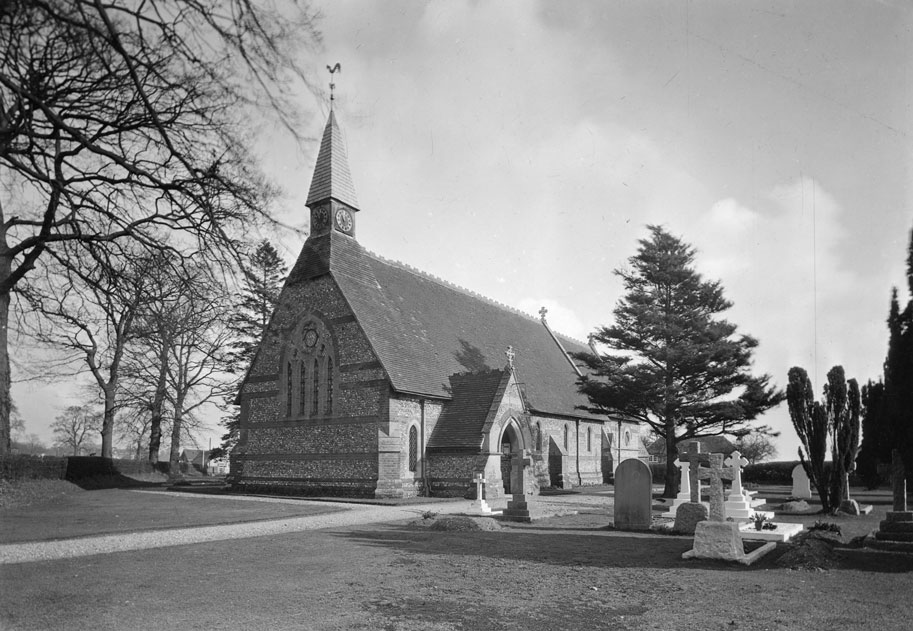There has long been a tradition in Coleshill of the existence of a very ancient chapel but it is difficult to disentangle the facts. It is known that in the reign of Edward I, the manor of Stocks Place was held by the de Bohun family and it is very probable that, according to custom, the chapel was attached to the manor house. Confirmation of this is given by the fact that much later, foundations of such a building were found when a field was ploughed at Chapel Farm which adjoined the manor. There are other accounts of remains, possibly ecclesiastical, being found during digging in Brainford Wood (now Brentford). They included curious paving work known as diced work and a weathercock. It nay be that this was an oratory attached to a great house but of such a house there is no record.
We pass from the range of legend to that of history in the year 1649. At that time there were forty families, consisting of 200 persons, living in this hamlet of Coleshill. They earnestly desired a church in the place and the authorities agreed that it was fit for such a church to be erected and endowed with the tithes which then amounted to £70 per annum. Unfortunately no further records of this church have been found nor of the place where it was situated, and it was not until 1861 that the present church of All Saints was built and dedicated on November 7th, 1861. The church was built of characteristic brick and flint from a design by G. E. Street. It has been well cared for during its life of over 100 years and has been beautified by many generous gifts.
The centenary of the church was celebrated a little too early owing to a mistaken date. Bishop Hay, then Bishop of Buckingham, preached at the festival service and at a party afterwards the village choral society gave a performance of 'Trial by Jury' by Gilbert and Sullivan. The first gift day was held at this time and over £100 was given as a hundredth birthday present to the church. Part of this money was used to buy figures for the Crib, which still delights young and old every Christmas.
In 1905 the Revd. C.G. Briggs was Rector of Amersham-with-Coleshill and working with him were the Revd. C.E. Salmon and the Revd. G.R. Slack. Between then they took the Sunday services at Coleshill at 11.00a.m. and 6.00p.m. with a celebration of the Holy Communion at 12 noon. The Revd. G.R. Slack lived at the Old Parsonage him with his little dog, Fidget. In 1908 the Revd. C. G.C. Walker became Priest-in-Charge, but finding the hill from the Old Parsonage to the Church too tiring, he moved to Waller's Oak, which remained the Parsonage during the rest of his time at Coleshill and that of his successor, the Revd. W.F. Thomas. It seemed difficult, however, to find a house which suited everyone and when the Revd. Y.L.Brasnett, a bachelor, came to the village, he found Waller's Oak far too large and moved to New Cottages. Following this, the Revd. Kenneth Munford went to The Haven and later, during the Revd. Frank Urch's time, Ivy Cottage (now Mount House) was bought as a permanent home for the Priest-in-Charge at Coleshill.
There is an interesting paragraph in the Parish Magazine for May 1919 in connection with the sale of Wallers Oak. The Governors of the Samaritan Hospital bought the house for a Convalescent Home in place of their quarters at Brickwick - this, they said, being a strong testimonial to the healthiness of Coleshill as the patients improved with much rapidity after a short stay in the village. Further, we are told, that the famous Brickwick donkey, utterly indifferent to the advantages of quick locomotion, was to be replaced by a pony which it was hoped would get to the station in less than the customary minimum of two hours.
The first wedding recorded in the Register of All Saints Church was on August 6th, 1911 when Arthur Israel Slade and Lizzie Worrell were married. They lived in the cottage next to Thornbury which later was burned down.
In 1919 again recorded in the Parish Magazine there is an account of a meeting held to discuss the question of a War Memorial, when it was decided that All Saints should, if possible, have a Churchyard dedicated to the memory of the fallen. The ground later was given by the Rector for burials and was consecrated on November 28th 1920. The first funeral, in 1921, was that of Thomas Aldridge.
reprinted from village newsletters, May and August 1966

